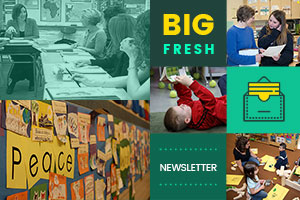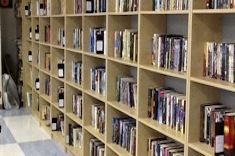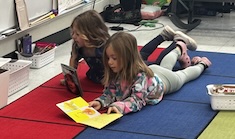Library
Choice Literacy Articles & Videos
The Choice Literacy library contains over 3,000 articles and 900 videos from 150+ contributors. Classic Classroom and Literacy Leadership subscribers have access to the entire library. Content is updated continuously, with five to six new features published each week.
Latest Content
Kindergarten Celebration of Writing
Molly James encourages us to consider ways to make a writing celebration meaningful. You’ll be inspired by her kindergarten writing celebration.
August 16, 2024: Starting Strong
This week’s newsletter is about starting the school year.
Revisiting: Getting to Know My Students
Mandy Robek decided that despite the increasing pressures and time-consuming expectations, she will nourish healthy relationships with students. Here are some tried-and-true practices that she wants to maintain.
August 9, 2024: Good Vibes to Start the School Year
This week’s newsletter is full of good vibes to start the school year.
Fostering Reading Lives in the Library
Gigi McAllister fosters engaged reading lives through goal-setting in the library. She shares ways we can encourage all readers to have robust reading lives.
Advice from Hanks
Becca Burk shares three tips Tom Hanks gave to educators during a keynote address at NCTE. If you’re looking for inspiration, this is just the article for you!
August 2, 2024: School and Classroom Libraries
This week’s newsletter is about school and classroom libraries.
Story Walks
Christy Rush-Levine invites students into a story walk. While many of our school activities require students to sit still and be quiet, story walks with wordless books are a simple way to invite students to move and talk, with powerful outcomes.
Early Writing Opportunities in the Library
Gigi McAllister shares informal writing opportunities for students in the school library. Informal and engaging writing activities where students have lots of choice and encouragement make them feel empowered as writers, help them generalize the writing skills they are learning in the classroom, and create joyful writing experiences.
July 26, 2024: Spinning Ideas for the New School Year
This week’s newsletter is full of inspiring ideas for the new school year.
June 28, 2024: Summer Reading
This week’s newsletter is full of booklists to help with your summer reading.
June 21, 2024: Fluency
This week’s newsletter is about building fluency.
Tips for Interactive Word Study
Lisa Mazinas offers tips for building fluency in elementary readers.
Fluency Practice in Middle School
Leigh Anne Eck tackles fluency strategies with her middle school readers.
June 14, 2024: Thinking More Deeply About Characters
This week’s newsletter is about thinking more deeply about characters.
June 7, 2024: Nurture Independence
This week’s newsletter is about nurturing independence.
May 31, 2024: Don’t Miss the Joy
This week’s newsletter is about finding joy in our work.
Eight Tips to Make Virtual Learning Equitable and Accessible for All Students
Lisa Mazinas reminds us of ways to make virtual learning equitable and accessible.
Responding to Appeals for Help
Dana Murphy outlines three options to respond to a student who is stuck when reading and looking to the teacher for the answer. By being mindful when students appeal for help, we can make intentional, on-the-spot decisions to empower students to become better readers.
Purposeful Play
Jodie Bailey makes a case for purposeful play with her middle school students. To strengthen reading habits, we offer exposure to a wide variety of books, time to read, and opportunities to discuss ideas. In math classrooms, students need similar opportunities to explore and play.
May 24, 2024: Holiday Reading
This week’s newsletter is about the unexpected learning that happens over time.
May 17, 2024: What Surprises You?
This week’s newsletter is about the unexpected learning that happens over time.
The Power of Story
Becca Burk reminds us of the power of story and community when she uses a social story to help a kindergartner overcome the fear and anxiety from being forgotten on the bus. Becca shows us how to use a social story to develop confidence to overcome difficulties.
Your Voice Matters
Jodie Bailey shares a picture-book version of Martin Luther King Jr.’s I Have a Dream speech and then gives students time to reflect on the message. While math class might seem like an unusual place to help students consider their identity and place in the world, Jodie inspires teachers to offer space and time for students to find their voice…while making direct connections to math standards.
May 10, 2024: Elevate Readers’ Thinking
This week’s newsletter is about elevating readers’ thinking.
Examining Power Dynamics
Gretchen Schroeder leads her students to consider the power and privilege in the texts they read. By creating a power continuum, students become more aware of issues of power and oppression in society. Once this happens, they can move to discussions of how to take action for positive social change.
An Invitation to Elevate Readers’ Thinking Through Conversation
Melissa Quimby offers structures to help elevate readers’ thinking through book club conversations. You’ll love putting these practical ideas into play in your own classroom—and be awed by the depth of your readers’ understandings.
Teaching Students to Self-Monitor
Dana Murphy explicitly teaches students how to self-monitor through modeling and using an anchor chart that clearly defines each step.
May 3, 2024: Invaluable Teaching Tools
This week’s newsletter is about invaluable teaching tools.
Fostering a Love of Reading in All Students
Lisa Mazinas reminds us of the importance of fostering a love of reading in all students. She offers specific ways to reconnect students with the enjoyment of reading.
Browse Content By
Type
Category
- Assessment Tools
- Big Fresh Archives
- Booklists
- Choice Numeracy
- Classroom Design
- Common Core
- Community Building
- Conferring
- Content Literacy
- Digital Literacy
- English Language Learners
- Equity
- Family Relations
- Free Samples
- Guiding Groups
- Leadership
- Literacy Coaches
- Mentor Texts
- Minilessons
- New Teacher Mentors
- Podcasts
- Poetry
- Quote Collections
- Reading Strategies
- Self Care
- Struggling and Striving Learners
- Talking and Listening
- Teacher Study Groups
- Teaching Reading
- Teaching Writing
- Word Study and Vocabulary
Author
- Melissa Quimby
- Nawal Qarooni
- Gwen Blumberg
- Julie Cox
- The Lead Learners
- Hannah Tills
- Josie Stewart
- Ruth Metcalfe
- Mallory Messenger
- Becca Burk
- Jodie Bailey
- Vivian Chen
- Mary Brower
- Tiffany Abbott Fuller
- Stephanie Affinito
- Ruth Ayres
- Leigh Anne Eck
- Heather Fisher
- Shari Frost
- Julie Johnson
- Suzy Kaback
- Gigi McAllister
- Shirl McPhillips
- Melanie Meehan
- Cathy Mere
- Debbie Miller
- Tara Barnett and Kate Mills
- Tammy Mulligan
- Dana Murphy
- Bitsy Parks
- David Pittman
- Brenda Power
- Heather Rader
- Matt Renwick
- Mandy Robek
- Christy Rush-Levine
- Gretchen Schroeder
- Jen Schwanke
- Brian Sepe
- Katherine Sokolowski
- Stella Villalba
- Jennifer Vincent
Grade Level
Choice Literacy Membership
Articles
Get full access to all Choice Literacy article content
Videos
Get full access to all Choice Literacy video content
Courses
Access Choice Literacy course curriculum and training


















